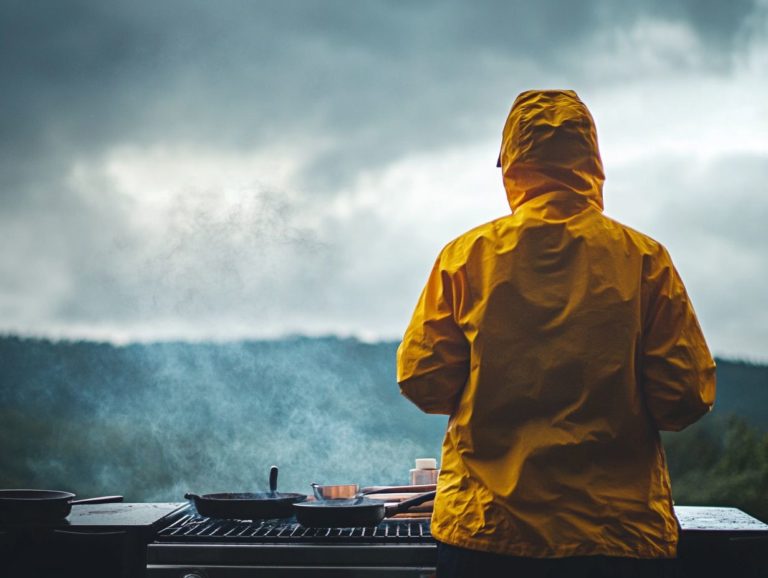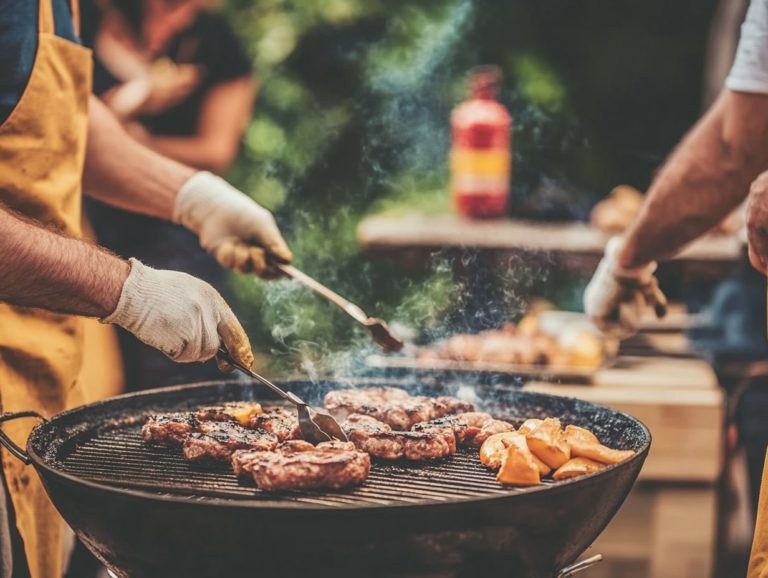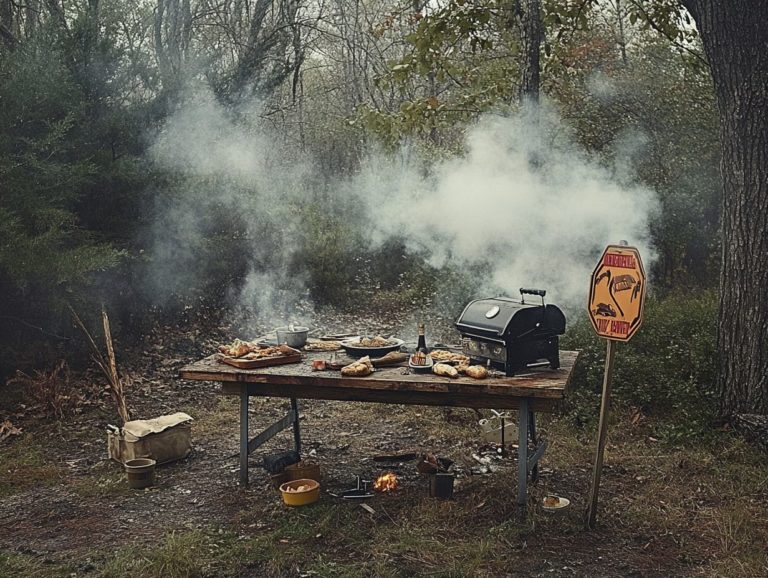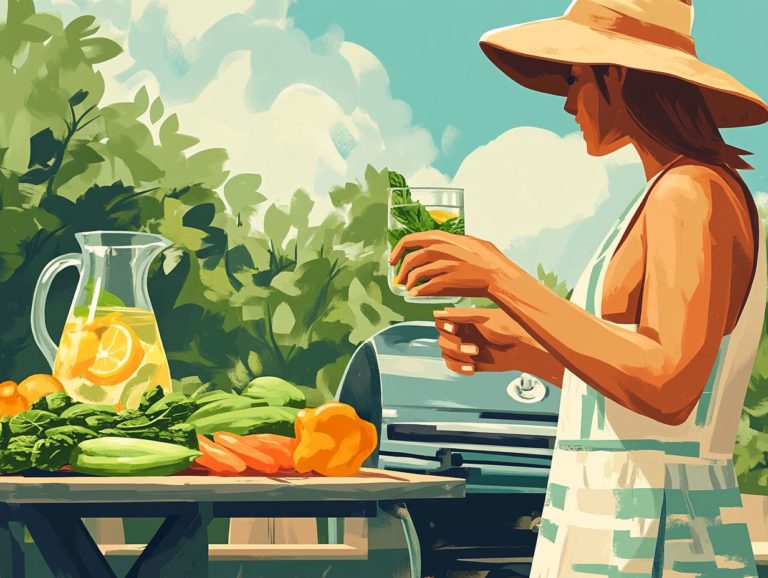Staying Safe While Cooking in Remote Locations
Cooking in remote locations can be an exhilarating adventure, but it also presents unique challenges regarding cooking safety.
You need to consider everything from fire prevention to food hygiene. Careful planning and awareness are essential for a successful outdoor cooking experience. This guide provides you with the essential supplies, fire prevention strategies, cooking tips, and hygiene tips to help you cook safely and enjoyably amidst nature.
Emergency protocols are also included, ensuring you re prepared for unexpected situations, particularly regarding cooking accidents.
Prepare yourself to fully embrace your culinary journey in the great outdoors, focusing on cooking with confidence!
Contents
- Key Takeaways:
- Preparing for Cooking in Remote Locations
- Fire Safety in Remote Cooking
- Preventing and Managing Fires
- Food Safety in Remote Cooking
- Hygiene and Sanitation in Remote Cooking
- Dealing with Emergencies in Remote Cooking
- Tips for Safe and Enjoyable Cooking in Remote Locations
- Frequently Asked Questions
- What are some important safety tips to consider when cooking in remote locations?
- How can I prevent foodborne illnesses while cooking in remote locations and ensure kitchen cleanliness?
- What should I do if I see a wildfire while cooking in a remote location?
- What safety measures should I follow when cooking over an open fire?
- How can I stay safe when using a camping stove in a remote location?
- What should I do if I am cooking in a remote location and a medical emergency occurs, particularly with children safety in mind?
Key Takeaways:

- Always bring essential supplies and equipment for cooking in remote locations to ensure a safe and enjoyable experience.
- Be prepared and knowledgeable about fire safety to prevent and manage fires in remote cooking settings.
- Practicing proper food safety is crucial, including storage and handling, to avoid foodborne illnesses while cooking with oil in remote locations.
Preparing for Cooking in Remote Locations
Preparing to cook in remote locations requires a careful plan to guarantee a safe and enjoyable experience. Whether you’re camping in the woods or tailgating at a lively sports event, gathering the appropriate cooking appliances and supplies is crucial.
Adhering to fire safety measures is non-negotiable. Be aware of potential fire hazards, keeping flammable items at a safe distance while considering the cooking methods best suited for outdoor settings. This approach minimizes risks and enhances your overall experience.
Essential Supplies and Equipment
When you set out on a culinary adventure in remote locations, gathering the right essential supplies and equipment is vital for safety and efficiency in your cooking process.
Equipping yourself with various cooking appliances, such as portable stoves and compact grilling units, can significantly elevate your outdoor cooking experience. Don’t forget about essential utensils like sturdy cutting boards, reliable knives, and durable cookware that can endure the challenges of outdoor use.
Safety should always be at the forefront of your mind. Having a fire extinguisher nearby can avert potential disasters, while a well-stocked first aid kit ensures that minor mishaps won’t derail your adventure due to staying alert while cooking.
It’s also important to remember the value of smoke detectors and maintaining kitchen cleanliness. These factors not only enhance safety but also contribute to the overall enjoyment of cooking in the great outdoors, especially during fire safety month.
Fire Safety in Remote Cooking
Fire safety in remote cooking is essential, as the distinctive environment presents particular risks that demand your heightened awareness and caution. Understanding the dangers of cooking outdoors without supervision is crucial for ensuring a safe experience.
By staying vigilant, you can effectively prevent kitchen fires and other fire hazards, including the risks associated with unattended cooking.
Preventing and Managing Fires
Preventing and managing fires while cooking in remote locations calls for a proactive approach alongside fire awareness. Recognizing potential fire risks is crucial, and it s important to put effective fire prevention measures into action.
To enhance your safety, make it a priority to maintain a clean cooking area, ensuring it s free from any flammable materials like paper, cloth, or improperly stored ingredients that contribute to fire risks. A tidy workspace isn t just aesthetically pleasing; it s a crucial step in fire safety.
Keep your area clean and integrate functioning fire alarms into your cooking environment. These alarms provide early warnings that can be lifesaving in the event of a grease fire.
It s also important to know where the nearest emergency services are and to have their contact information handy, especially in case of kitchen accidents. Act quickly if a situation escalates. Understanding how to respond quickly in the event of a fire can make all the difference, enabling you to evacuate safely and minimize any potential damage.
Food Safety in Remote Cooking
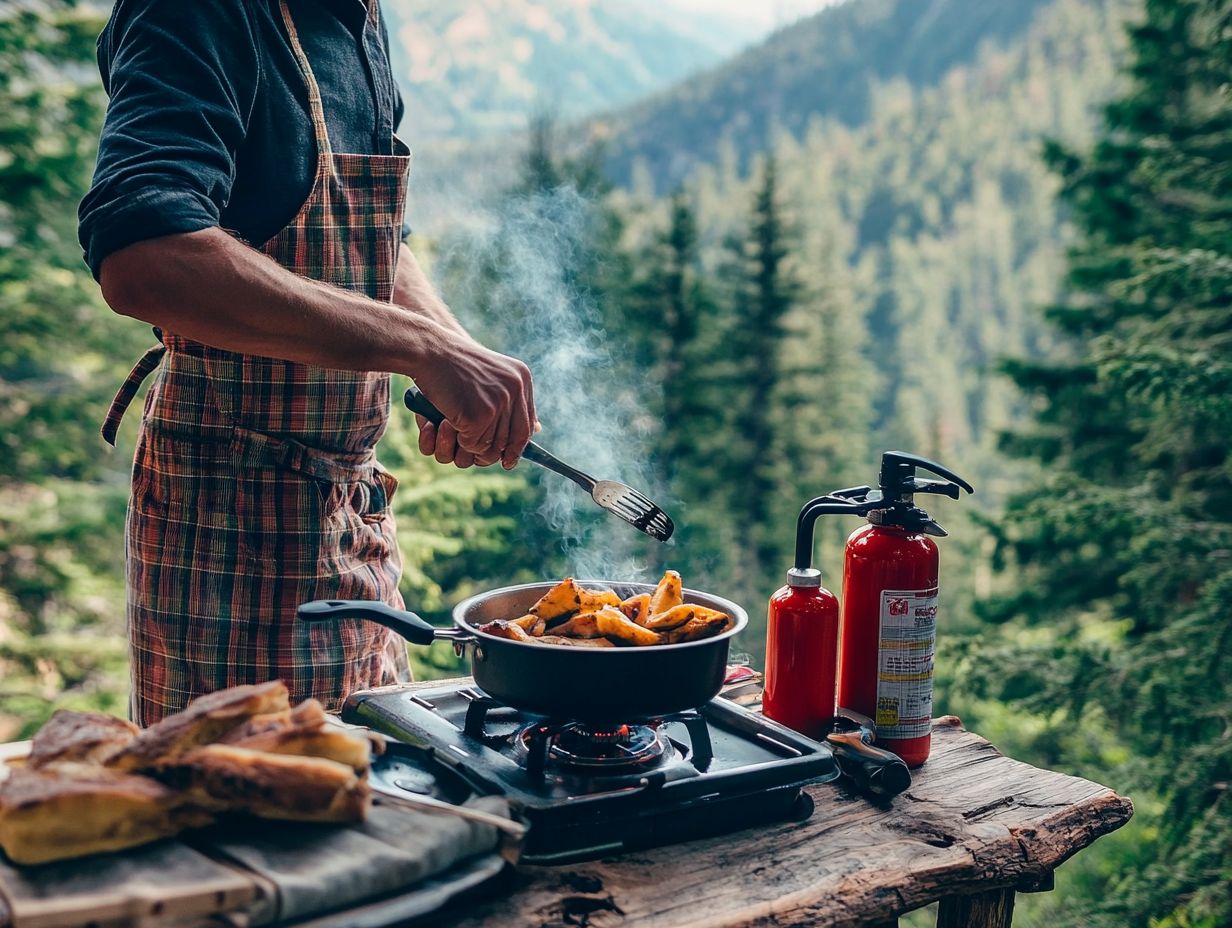
Maintaining food safety in remote cooking environments is crucial for preventing foodborne illnesses and ensuring a delightful culinary experience, particularly when handling perishable items and practicing cooking precautions. By prioritizing safety, you can enhance both the enjoyment and quality of your meals.
Proper Storage and Handling of Food
Proper storage and handling of food are essential elements of food safety, ensuring that all your ingredients remain safe for consumption throughout your remote cooking adventure by adhering to safety guidelines.
When planning meals in outdoor settings, keep food at safe temperatures to prevent microbial growth. Perishable items should be stored in airtight containers and kept on ice whenever possible. Use coolers to keep food at safe temperatures. It s also vital to avoid cross-contamination, which occurs when raw food comes into contact with cooked food, as this can cause illness.
Maintaining cleanliness of your cooking surfaces is equally important. Regularly sanitize utensils and countertops to contribute to a safer cooking environment. Encourage a practice of keeping a minimum distance of six feet when preparing food near potential contaminants, such as waste disposal areas, to further enhance safety and help retain the freshness of all your ingredients, ensuring children’s safety and pet safety.
Hygiene and Sanitation in Remote Cooking
Hygiene and sanitation are essential when it comes to ensuring safe cooking practices, especially in remote locations where resources can be scarce. In such settings, maintaining cleanliness becomes not just important, but paramount.
Cleaning and Waste Disposal
Effective cleaning and waste disposal are crucial for maintaining kitchen cleanliness and hygiene, especially when cooking in remote locations.
These practices elevate your dining experience while safeguarding the surrounding environment from potential contaminants by promoting cooking responsibility. By using biodegradable soap for washing utensils and surfaces, you ensure that your culinary area remains pristine, contributing to overall kitchen hygiene. Composting food scraps further promotes a sustainable ecosystem. Follow proper waste disposal techniques such as sealing trash to deter wildlife to demonstrate your commitment to preserving nature.
This mindful approach fosters a shared sense of responsibility among outdoor cooks, encouraging everyone to prioritize hygiene and sanitation during their culinary adventures while adhering to fire prevention measures. By embracing these best practices, you contribute positively to both your personal wellbeing and the health of the ecosystem.
Dealing with Emergencies in Remote Cooking
Navigating emergencies in remote cooking scenarios is essential; being well-prepared can greatly reduce the effects of unexpected events and safeguard the well-being of everyone involved.
First Aid and Emergency Protocols
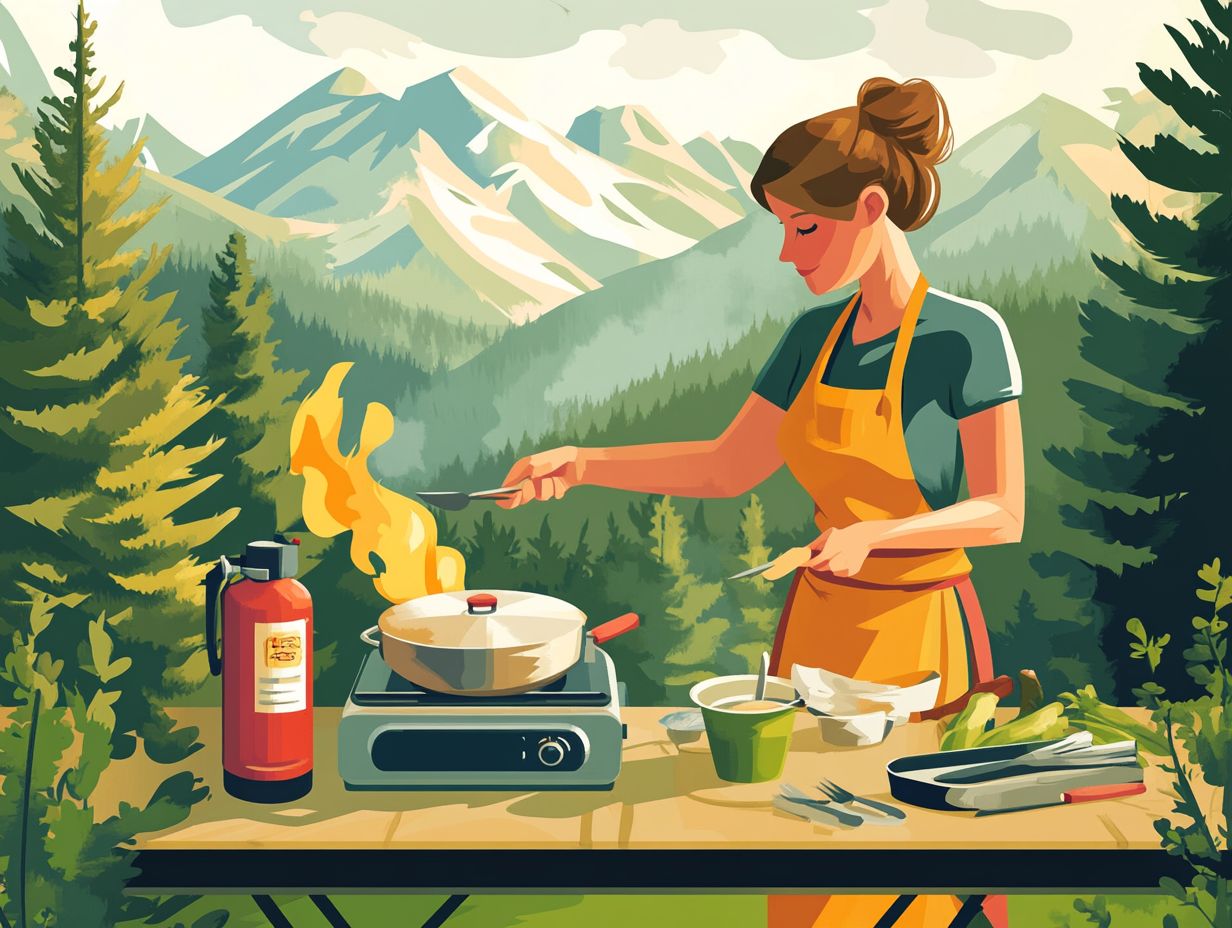
Having a well-stocked first aid kit and knowing emergency protocols is crucial for effectively managing kitchen accidents, especially when you’re cooking in remote locations and prioritizing cooking awareness.
To equip your kit, include essentials like fire extinguishers and:
- antiseptic wipes for cleaning cuts,
- adhesive bandages in various sizes for minor injuries,
- burn cream to handle any cooking mishaps that might arise.
You should also have sterile gauze and medical tape on hand for more serious wounds. Familiarizing yourself with emergency protocols is just as vital. For instance, knowing how to apply pressure to stop bleeding or cool a burn under running water for several minutes can truly be lifesaving.
It’s also important to know about nearby emergency services whether it’s a local clinic or a helpline offering peace of mind and ensuring that help is readily accessible in the event of a more serious incident involving home fires.
Tips for Safe and Enjoyable Cooking in Remote Locations
To guarantee safe and enjoyable cooking experiences in remote locations, it’s essential to embrace a collection of cooking tips that prioritize safe cooking while enhancing your overall cooking experience.
Making the Most of Your Experience
Maximizing your cooking experience in remote locations means embracing techniques that elevate flavor while prioritizing cooking cleanliness and safety in the kitchen.
With a touch of creativity, you can turn simple ingredients into mouthwatering dishes that not only satisfy your cravings but also tantalize your senses. Remember, responsible cooking practices are vital for a successful outdoor adventure.
Staying aware of your surroundings, including fire safety and interactions with wildlife, is crucial to avoid unforeseen mishaps.
By prioritizing safety alongside innovative cooking methods, including being vigilant about fire alarms, you create an environment where everyone can unwind and relish their meal. This exciting mix of safety and creativity leads to unforgettable meals enjoyed under the open sky, ensuring every moment is cherished while practicing fire prevention.
Watch this video for more cooking safety tips!
Frequently Asked Questions
What are some important safety tips to consider when cooking in remote locations?
It is important to have a fire extinguisher, first aid kit, and proper cooking equipment on hand. Also, be aware of any potential hazards in the surrounding area, such as wildlife or uneven terrain.
How can I prevent foodborne illnesses while cooking in remote locations and ensure kitchen cleanliness?
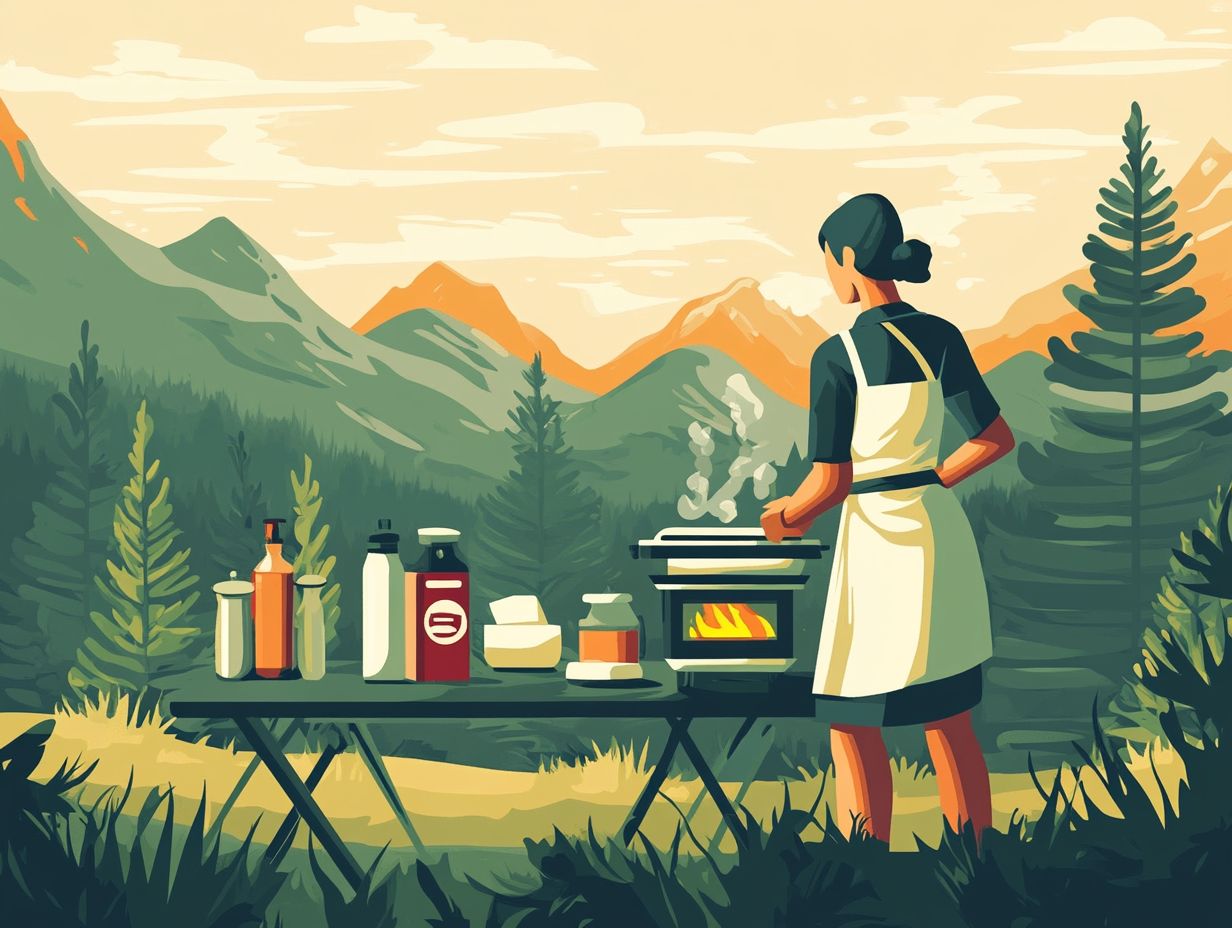
Always wash your hands before handling food. Make sure to properly store and cook food at the correct temperatures. Avoid cross-contamination by using separate cutting boards and utensils for raw and cooked foods. Cross-contamination refers to the transfer of harmful bacteria from one surface to another.
What should I do if I see a wildfire while cooking in a remote location?
If you see a wildfire, act fast by extinguishing any open flames and safely moving away from the fire. Follow emergency protocols and contact the appropriate authorities as soon as possible.
What safety measures should I follow when cooking over an open fire?
Always ensure you have a safe and stable cooking surface. Never leave a fire unattended and keep a bucket of water or sand nearby to quickly extinguish the fire if needed.
How can I stay safe when using a camping stove in a remote location?
Always read and follow the instructions for your camping stove. Use it in a well-ventilated area and never leave it unattended while it is in use. Properly store fuel canisters away from heat sources.
What should I do if I am cooking in a remote location and a medical emergency occurs, particularly with children safety in mind?
First, assess the situation. Call for emergency assistance if you need it.
If you know first aid, use it. Every second counts in an emergency, so act fast!
If you can’t get help, use anything you have like a whistle or signal mirror to call for assistance.



